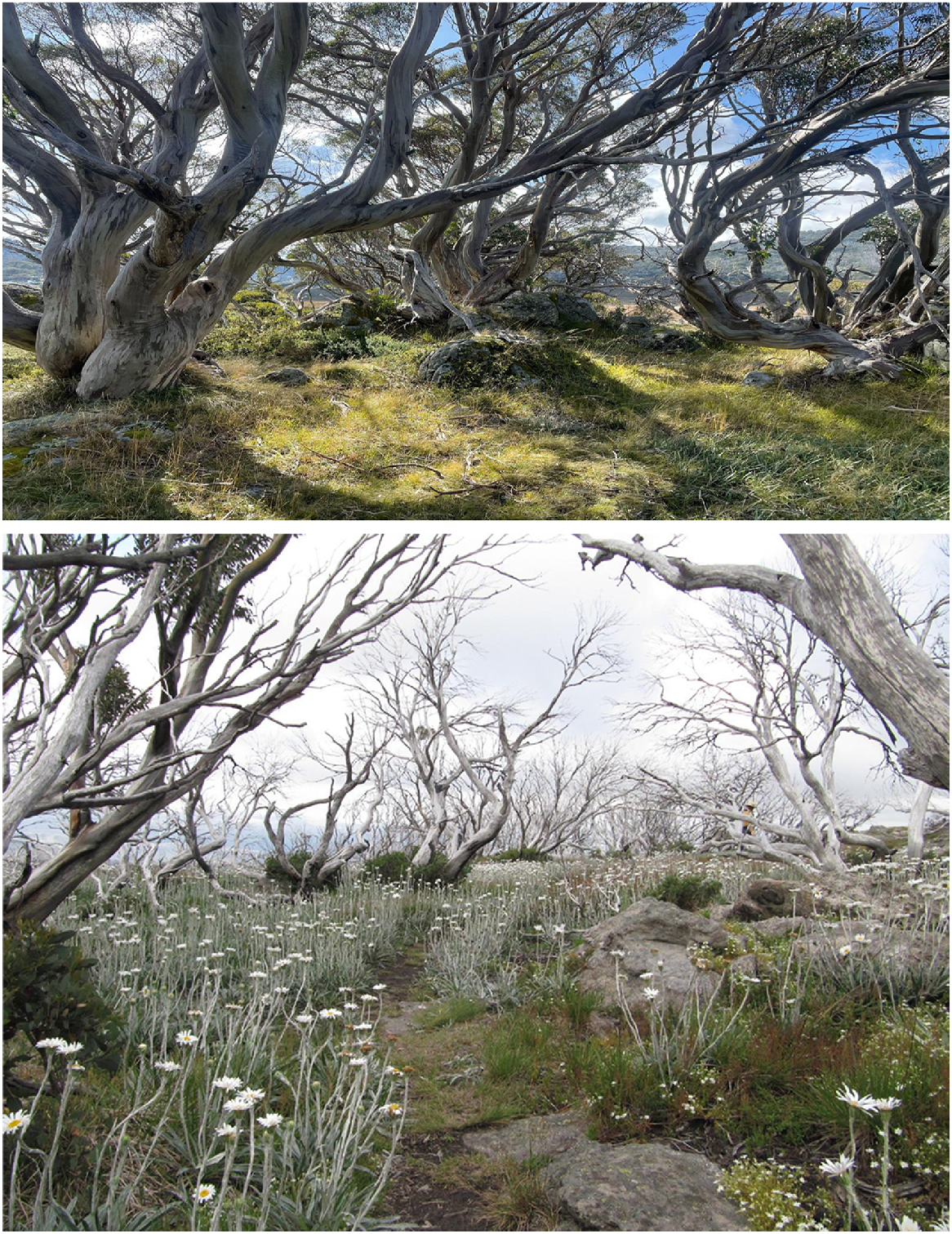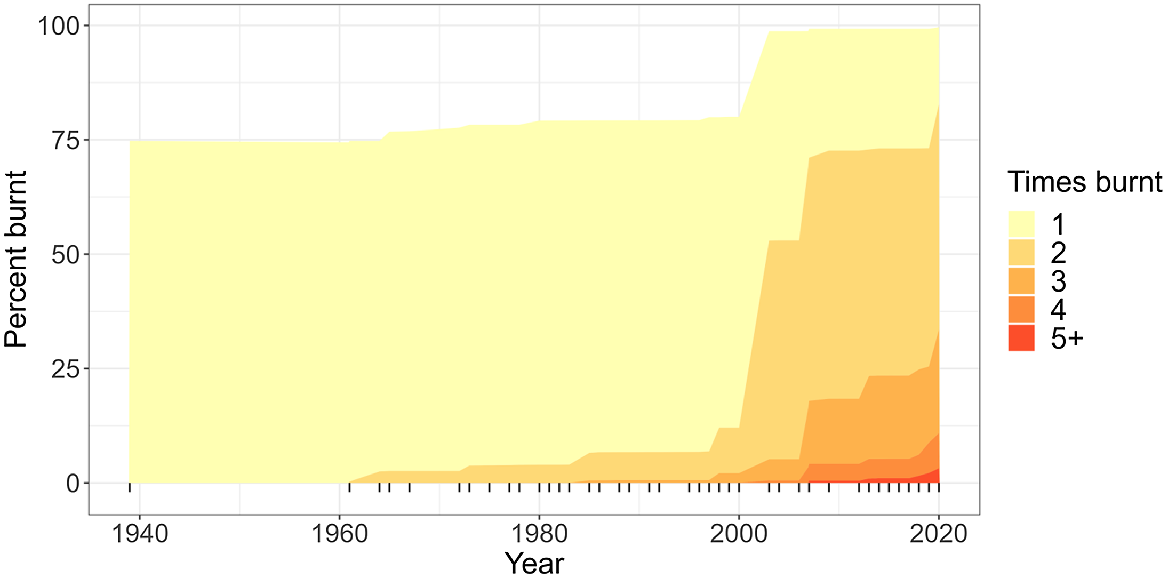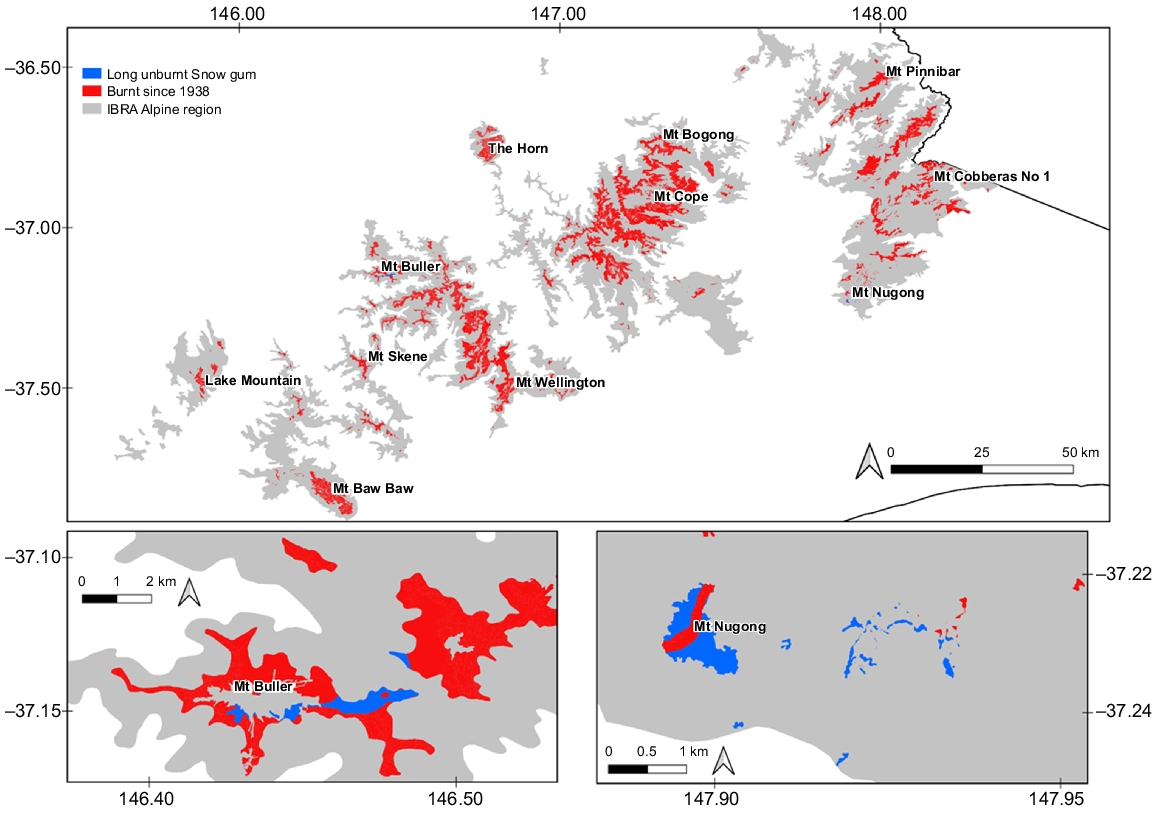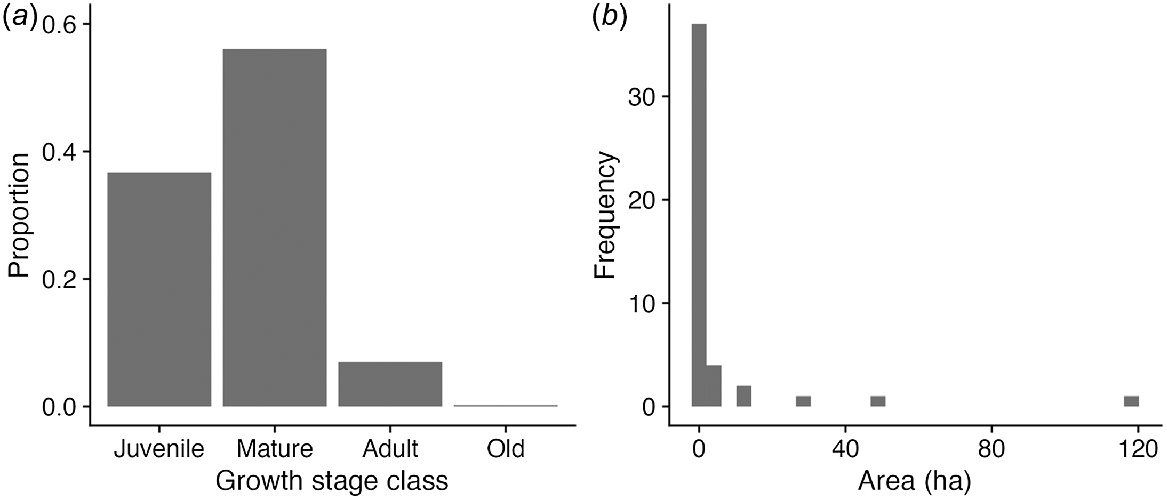Long-unburnt stands of snow gum (Eucalyptus pauciflora Sieber ex Spreng) are exceedingly rare in the Victorian Alps: implications for their conservation and management
John W. Morgan A B * , Michael Shackleton A B and Zac C. Walker A C
A B * , Michael Shackleton A B and Zac C. Walker A C
A
B
C
Abstract
The nature of Australia’s high mountains is changing. Recent, repeated landscape-scale fires have burnt much of the subalpine forests dominated by snow gum (Eucalyptus pauciflora). Long-unburnt snow gum forests are important for ecosystem services, have socio-cultural benefits, and conservation values, but they are now exceedingly rare, comprising <1% of snow gum forests in the Victorian Alps. We identify where long-unburnt snow gum stands persist in the Victorian Alps and outline why management intervention is necessary to protect unburnt refuges and, more broadly, to allow mature/adult stands (such as occur on the Baw Baw Plateau) to develop into future old forests.
Keywords: alpine ecology, alpine regeneration, conservation biology, ecosystem dynamics, plant ecology.
Introduction
Subalpine forest communities throughout the Australian Alps are mostly dominated by a single tree species, namely, Eucalyptus pauciflora Sieber ex Spreng. These trees are multi-stemmed, slow-growing and persist in areas where snow and freezing temperatures are common in winter (Farrell and Ashton 1973). They resprout from lignotubers after fire (i.e. are ‘niche persistors’ sensuBond and Midgley 2001), but resprouting ability declines with an increasing fire frequency (Fairman et al. 2017). An old-growth structure, i.e. trees with few, large stems and hollows, takes many decades to develop. Cheal (2010) suggested that this stand stage occurs when snow gums remain unburnt for 85+ years. Most of the habitat of snow gum in the Victorian Alps has been burnt by one or multiple landscape fires over the past century (Fairman et al. 2017; Lindenmayer and Taylor 2020). This has clearly affected their structure (i.e. number of stems and their diameter, the distribution of canopy, and crown height) and stand size-class distribution (Coates 2015; Fairman et al. 2017). Fires promote an increase in tree and stem density (Coates 2015), with stem thinning occurring in the absence of fire (Ashton and Hargreaves 1983). Snow gum forests are susceptible to being burnt in landscape-scale fires because they are surrounded (on their downslope margin) by montane and foothills forests dominated by flammable Eucalyptus species (Bowman et al. 2014). Increasingly, recent fire is creating a more flammable landscape because of positive feedbacks in the post-disturbance phase (Zylstra 2018).
No one definition exists for old-growth forest (Lindenmayer and Taylor 2020). Indeed, Lindenmayer and Bowd (2022) suggested that definitions of old growth are typically ecosystem-specific and based on the time required to develop key ecosystem attributes (such as old, dominant overstorey trees). For resprouter species such as snow gum, the age of a tree (its lignotuber) invariably exceeds the age of individual trunks. Old-growth concepts in high mountains, therefore, must encompass the structure of the forest because it is related to the time-since-last-disturbance (e.g. fire). Trees with few, large stems, with or without obvious hollow development, provide the evidence for old-growth forests and these are an outcome of long periods without fire that kills aerial stems, leading to basal resprouting from the lignotuber (Coates 2015; Lindenmayer and Taylor 2020; Fig. 1). Coates (2015) observed that snow gum in long-unburnt sites typically had fewer than four stems and a high basal area.
(Top) Snow gum (Eucalyptus pauciflora) trees showing a long-unburnt form that includes a large girth and few main stems. (Bottom) Fire typically causes the death of stems in snow gum, with numerous stems sprouting from the basal lignotuber and then growing slowly. This stand, on the Bogong High Plains, was burnt in February 2007 and by January 2011, the canopy was still well-within the pre-fire canopy. (Photos: John Morgan).

Long-unburnt forests, including those dominated by snow gums, are important for ecosystem services, have socio-cultural benefits, and unique conservation values (Gilhen-Baker et al. 2022). For example, old snow gum stands have been shown to provide the most effective means of water collection and regulation (Costin 1967). Hence, fire may have a considerable impact on the ability of these forests to sustain snow accumulation and persistence, retain soil moisture by intercepting rain and to prevent erosion (Schwartz et al. 2021). In this study, we quantify the extent of long-unburnt snow gum in Victoria by using GIS layers focusing on ecosystem extent in relation to fire-history data. Our aim was to identify where long-unburnt stands exist in the landscape. From these data, we make recommendations relevant to conservation policy, including prioritising the protection of snow gum stands both before and during bushfires.
Methods
We first selected the Australian Alps IBRA bioregion (IBRA ver. 7, DAWE 2020) to define the extent of our study area, confining it to the State of Victoria where fire mapping is well documented. IBRA classifies Australia’s landscapes into large, geographically distinct bioregions on the basis of common climate, geology, landform, native vegetation and species information. The study area encompasses the mountainous region along the Great Dividing Range to the east and north-east of Melbourne. The majority of this land is public, either state forest or some form of conservation reserve. The landscape sits above 1200 m asl.
To define the distribution of our focal species (Eucalyptus pauciflora), we selected the Modelled 1750 Ecological Vegetation Classes (EVC; DEECA 2022a) and filtered them to only those that were likely to contain our target species as a dominant species, namely, EVC 37 and EVC 43 Subalpine Woodland. The modelled extent of EVCs prior to European settlement dataset is the estimated extent of vegetation at the EVC level prior to European settlement and is the widely-used benchmark for description of native vegetation in Victoria. It is modelled at a scale of 1:100 000 and is based on field data, environmental spatial data (soils, rainfall, topography) and historical records such as Parish plans. Such models imply that the extent of a current-day EVC has not changed since 1750; however, there is evidence that alpine and subalpine vegetation states can change rapidly (e.g. Verrall et al. 2023). Hence, we use EVC mapping as a landscape-scale approximation of historic snow gum vegetation distributions in Victoria and suspect that any changes that have occurred since 1750 are unlikely to alter our general findings about fire in this forest type.
The spatial layer characterising the distribution of snow gums was then overlaid with a fire-history dataset that contained information on the spatial extent of fires, primarily on public land across Victoria (DEECA 2022b). This dataset records each of the times an area was known to be burnt and represented a consecutive overlay of all fires recorded since 1900. In some cases, the precise localities of fires are not known and it was not possible to accurately reconstruct fire histories prior to 1939 (Zylstra 2006, 2018). Hence, we focus our study on wildfires in subalpine snow gum forest and woodlands from (and including) 1939; we excluded prescribed burns from the fire-history dataset. We also note that fire-history layers potentially underestimate unburnt heterogeneity within fire boundaries. Although more unburnt vegetation (at small scales) might exist within fire footprints than is depicted by the fire-history datasets, we focussed primarily on snow gum landscapes that have escaped fire entirely (i.e. at the stand level of multiple hectares).
To highlight the fire regimes of the Victorian Alps over the past century, we examined the frequency and extent of recurrent fires using the fire-history dataset (DEECA 2022b). To do this, we calculated the cumulative proportion of snow gum forests and woodlands that have experienced one or more fires since 1938. We present the data as a time series showing the proportion of snow gum vegetation that has experienced fires since 1938, highlighting the extent of the ecosystem that has been burnt one, two, three, four or five (or more) times. We calculated the proportion of snow gum forests and woodlands that are in each of the following four time-since-fire growth-stage classes identified by Cheal (2010) for this ecological fire group: Juvenile (0–12 years), Mature (12–45 years), Adult (45–85 years) and Old (85–125+ years since fire). This was undertaken by determining the time-since-fire and area of each polygon in the snow gum fire-history dataset outlined above. Area of each patch was calculated in QGIS 3.22.6 by using the area function within the field calculator. Time-since-fire was measured as the number of years between 2022 (the latest fire season in the dataset) and the year each polygon last burnt. Each polygon was then assigned to one of the four growth-stage classes on the basis of time-since-fire. Polygons without fire history since, and including, 1939 had no numerical value for time-since-fire and were assigned to the old-growth stage class. The total area for each class was then calculated and converted to a proportion of the total snow gum forest and woodland. To determine the spatial status of long-unburnt snow gum in the Victorian alps (i.e. classified as ‘old’ by Cheal 2010), the frequency and size of patches were assessed using a histogram.
Results
We found that only 0.5% of snow gum extent in the Victorian Alps has remained unburnt since 1938, with 91.8% of snow gum having been burnt at least once since 2000 (Fig. 2). Since 2000, the repeated incidence of fires has meant that >30% of snow gum stands have now been burnt three, four or five (or more) times since 1938 (Fig. 2). There are only three areas with long-unburnt snow gum stands (e.g. not burnt in 1939 or since). These occur around the Chalet at Mount Buffalo (approximately 3 ha), to the east and south of Mount Buller, and at Mount Nugong near Bentleys Plain in the eastern Alps (Fig. 3). Growth-stage diversity is very low, with most stands (>90%) being <45 years old (Fig. 4a). The largest extent of ‘adult’ growth-stage class (45–85 years since fire) occurs on the Baw Baw Plateau. Most long-unburnt growth-stage forests (85–125+ years since fire) are small in area, predominantly <5 ha (Fig. 4b).
Cumulative percentage of snow gum forest and woodland area that has been burnt in fires since the Black Saturday bushfires of 1939, illustrating the extent and frequency of fires in the Victorian Alps. Tick marks on the x-axis indicate years where fires have been recorded in snow gum.

Locations of unburnt snow gum stands since 1938 across the Victorian Alps. The IBRA Alpine region is shown in grey, the extent of unburnt snow gum in blue, and the extent of burnt snow gum (as of 2022) in red. The two main localities where snow gum forests and woodlands remain long-unburnt (at Mount Buller and Mount Nugong) are highlighted.

(a) Proportion of snow gum forests and woodlands in each of four growth-stage classes identified by Cheal (2010), including the following: Juvenile, 0–12 years since fire; Mature, 12–45 years since fire; Adult, 45–85 years since fire; and Old, 85–125+ years since fire. (b) Frequency distribution (number of patches) of the area (in hectares) of long-unburnt (‘old’ growth-stage class) snow gum forest and woodland patches in the Victorian Alps.

Discussion
Long-unburnt snow gum (Eucalyptus pauciflora) forest and woodland stands are exceedingly rare in the Victorian Alps. Very large (pre-1939) trees have all but disappeared from the landscape because of multiple large fires in the 21st century, many with overlapping fire boundaries. Many snow gum-dominated ecosystems have been burnt repeatedly since landscape-scale bushfires in 1939 (e.g. more than five times at Mount Buffalo), likely because of climatic factors (Lucas et al. 2007) and the development of an increasingly flammable landscape (Zylstra 2018). Growth-stage diversity is skewed towards mallee-form stands in early stages of recovery. Old-growth forest structure will be restored only in the prolonged absence of fires, although climate-driven increases in fire frequency and severity (Bradstock 2008; Canadell et al. 2021) make this outcome increasingly difficult to conceptualise.
It is well appreciated that climate refugia will be important in the Australian Alps for elevationally restricted species (Pickering et al. 2004; Laurance et al. 2011); however, as fire frequency increases, unburnt fire refugia will also become increasingly important if the rare examples of long-unburnt forests we have identified are to be protected. Fire refugia are locations disturbed less frequently or less severely by wildfire than is the surrounding vegetation matrix (Meddens et al. 2018). Current fire refugia supporting long-unburnt snow gum forests and woodlands are small in size and scattered across the bioregion. Long-unburnt stands deserve special consideration. Mount Nugong in the eastern Alps, a small area on Mount Buffalo (a fire refugia because of fire-suppression activities around ‘The Chalet’ and associated building infrastructure), and areas south and east of Mount Buller have, according to fire-history data, not been burnt in the 20th and 21st centuries. These forests are the longest-unburnt examples of snow gums in the Victorian Alps and are worthy of active protection from future fires. The Baw Baw Plateau is also worthy of special mention. It burnt entirely in 1939 but is now the largest area of once-burnt snow gum in the Victorian Alps. Forests there have the best opportunity to develop into ‘new’ old-growth stands; trees there are just reaching an old-growth state (85+ years old). Above and beyond their many ecological benefits, these forest stands will also provide countless future socio-cultural benefits which should not be overlooked when considering conservation policies (Wintle et al. 2020; Gilhen-Baker et al. 2022; Woinarski et al. 2023).
Fire exclusion (via well-resourced fire-prevention and -suppression activities) is likely to be imperative so as to preserve the landscape representation of long-unburnt snow gums in the coming decades, as well as to enable regenerating forests to develop old-growth features over time. However, the application of fuel reduction fire in unburnt snow gums is not appropriate to reduce fire risk (Coates 2015) because snow gums are very vulnerable to stem kill by fire (of any intensity), with forest collapse likely to occur with repeated fire (Fairman et al. 2017). Rather, there is evidence that snow gum forests are less flammable and less fire-prone with increasing time-since-fire (Zylstra 2013, 2018). Protection from fire while such forests are at their most flammable is a key challenge for conservation managers. A discussion about the need for proactive interventions to protect long-unburnt forest (and regenerating forests) from fire is therefore necessary, with clearly articulated, goal-oriented outcomes being central to decision-making. Plans and processes that are supported by society are more likely to achieve conservation outcomes than the current, largely ad hoc and reactionary approaches to biodiversity protection during bushfires (Woinarski et al. 2023).
So what is the likelihood that long-unburnt snow gum stands can be protected from fire in the future? The fate of biodiversity and ecological assets in wildfires can be influenced by management action (de Bie et al. 2023), as was illustrated in the Australian bushfires of 2019–2020. The use of watering systems to protect individual Wollemi pine (Wollemia nobilis) trees from fire was an obvious, exceptional example of proactive action, albeit for a species located at a single site (Woinarski et al. 2023). However, protecting biodiversity and ecological assets such as old-growth forests has generally not been a priority in past bushfires (Wintle et al. 2020). To guide decisions about biodiversity and ecological-asset protection during future bushfires, it is first necessary to clearly map the location of conservation assets (de Bie et al. 2023), as we have undertaken here for long-unburnt snow gum, and ensure that such information is readily available in fire agency spatial databases. This provides the context-specific information necessary to make value judgements. It is then necessary to prioritise biodiversity and ecological values for protection during bushfires, given this objective will almost always be subordinate to protection of human life and property (Woinarski et al. 2023). Even among conservation assets, there will be different values placed on their importance. We suggest that protection of remaining long-unburnt snow gum forests and woodlands should be a high priority; there is very little of this iconic stand-type in the Victorian Alps and old-growth stand structure is susceptible to being lost to just a single fire. Although the effects of fire are transitory on resprouting species, it takes many decades to form old-growth snow gum forest structure and, hence, old-growth forests and their ecological values are hard to replace in the short term. Each new fire confers an even greater importance on the diminishing old-growth habitats that remain (Wintle et al. 2020). Knowing where long-unburnt snow gums are found allows fire-response plans to be developed at a landscape scale, along with actions that are needed to protect assets under different fire scenarios. Such an approach was taken in the 2019–2020 bushfires in Namadgi National Park where unburnt vegetation was protected by using bulldozers that established containment lines to prevent fire spread into important ecological communities (de Bie et al. 2023). Advocacy for such actions needs to occur within incident management teams during bushfires, on the basis of plans prepared well before bushfires have even ignited (de Bie et al. 2023). Advocating for protection of long-unburnt forest assets during fire operations should be easier where there are few competing assets for protection, i.e. where there is lower risk to human life and property (de Bie et al. 2023), as is the case in National Parks and other public lands designated for conservation. Protection is more difficult in landscape-scale fires where fire behaviour is unpredictable; hence, there is need for fire-scenario planning.
Conclusions
Long-unburnt forests provide inspiration, valuable habitat and multiple ecosystem services, yet many of their values can be lost in a single fire. Old-growth forests are therefore assets of exceptional natural and cultural significance worthy of active protection. We hope that by mapping the distribution of long-unburnt snow gum stands in the Victorian Alps, we can better prepare for future fire events by prioritising their protection via pre-fire preparation or by the operational decisions made during bushfires.
Data availability
The data used in this research are available from the authors upon request. Note: Figs 2–4 were derived from publicly accessible datasets found at www.data.vic.gov.au.
Conflicts of interest
John Morgan is Co-Editor in Chief of Australian Journal of Botany. He had no role in the handling of the manuscript, the selection of the Associate Editor or reviewers, nor the editorial decision on the outcome of the review process.
Acknowledgements
The authors acknowledge that the Victorian Alps covers the traditional Country of the Bidawal, Monero-Ngarigo, Gunaikurnai, Jaithmathang, Taungurung, Mitambuta, Ngarigu-Currawong, Dhudhuroa, Waywurru and Wurundjeri communities. Libby Rumpff assisted with literature and Angie Haslem provided helpful insight into growth-stage structure and minimum tolerable fire intervals for snow gum communities. Iris Hickman provided helpful comments on the manuscript. Phil Zylstra and Cam Walker provided the initial spark that made us recognise just how important long-unburnt snow gum stands are in the Victorian Alps.
References
Bond WJ, Midgley JJ (2001) Ecology of sprouting in woody plants: the persistence niche. Trends in Ecology & Evolution 16, 45-51.
| Crossref | Google Scholar | PubMed |
Bowman DMJS, Murphy BP, Neyland DLJ, Williamson GJ, Prior LD (2014) Abrupt fire regime change may cause landscape-wide loss of mature obligate seeder forests. Global Change Biology 20, 1008-1015.
| Crossref | Google Scholar | PubMed |
Bradstock RA (2008) Effects of large fires on biodiversity in south-eastern Australia: disaster or template for diversity? International Journal of Wildland Fire 17, 809-822.
| Crossref | Google Scholar |
Canadell JG, Meyer CP, Cook GD, Dowdy A, Briggs PR, Knauer J, Pepler A, Haverd V (2021) Multi-decadal increase of forest burned area in Australia is linked to climate change. Nature Communications 12, 6921.
| Crossref | Google Scholar | PubMed |
Coates F (2015) Comparative changes in Eucalyptus pauciflora (Myrtaceae) stand structure after bushfires in Victoria. Cunninghamia 15, 1-11.
| Google Scholar |
DAWE (2020) Interim Biogeographic Regionalisation for Australia (IBRA) v. 7. Available at https://gis.environment.gov.au/gispubmap/rest/services/ogc_services/IBRA7_Regions/MapServer
de Bie K, Currey K, Rumpff L (2023) What did we learn about biodiversity management, policy and operations from the 2019-20 wildfires? In ‘Australia’s megafires: biodiversity impacts and lessons from 2019-2020’. (Eds L Rumpff, SM Legge, S van Leeuwen, BA Wintle, JCZ Woinarski) pp. 377–388. (CSIRO Publishing)
DEECA (2022a) Native vegetation – modelled 1750 ecological vegetation classes. Available at https://discover.data.vic.gov.au/dataset/native-vegetation-modelled-1750-ecological-vegetation-classes
DEECA (2022b) Fire history records of fires across Victoria showing the fire scars. Available at https://discover.data.vic.gov.au/dataset/fire-history-records-of-fires-across-victoria-showing-the-fire-scars
Fairman TA, Bennett LT, Tupper S, Nitschke CR (2017) Frequent wildfires erode tree persistence and alter stand structure and initial composition of a fire-tolerant sub-alpine forest. Journal of Vegetation Science 28, 1151-1165.
| Crossref | Google Scholar |
Farrell TP, Ashton DH (1973) Ecological studies on the Bennison high plains. The Victorian Naturalist 90, 286-298.
| Google Scholar |
Gilhen-Baker M, Roviello V, Beresford-Kroeger D, Roviello GN (2022) Old growth forests and large old trees as critical organisms connecting ecosystems and human health. A review. Environmental Chemistry Letters 20, 1529-1538.
| Crossref | Google Scholar | PubMed |
Laurance WF, Dell B, Turton SM, Lawes MJ, Hutley LB, McCallum H, Dale P, Bird M, Hardy G, Prideaux G, Gawne B, McMahon CR, Yu R, Hero J-M, Schwarzkopf L, Krockenberger A, Douglas M, Silvester E, Mahony M, Vella K, Saikia U, Wahren C-H, Xu Z, Smith B, Cocklin C (2011) The 10 Australian ecosystems most vulnerable to tipping points. Biological Conservation 144, 1472-1480.
| Crossref | Google Scholar |
Lindenmayer D, Bowd E (2022) Critical ecological roles, structural attributes and conservation of old growth forest: lessons from a case study of Australian mountain ash forests. Frontiers in Forests and Global Change 5, 878570.
| Crossref | Google Scholar |
Lindenmayer D, Taylor C (2020) Extensive recent wildfires demand more stringent protection of critical old growth forest. Pacific Conservation Biology 26, 384-394.
| Crossref | Google Scholar |
Meddens AJH, Kolden CA, Lutz JA, Smith AMS, Cansler CA, Abatzoglou JT, Meigs GW, Downing WM, Krawchuk MA (2018) Fire refugia: what are they, and why do they matter for global change? BioScience 68, 944-954.
| Crossref | Google Scholar |
Schwartz A, McGowan H, Callow N (2021) Influence of bushfire on accumulation and ablation of a marginal montane snowpack in snow gum forests. Journal of Hydrology 603, 126795.
| Crossref | Google Scholar |
Verrall B, Norman P, Mackey B, Fisher S, Dodd J (2023) The impact of climate change and wildfire on decadal alpine vegetation dynamics. Australian Journal of Botany 71, 231-251.
| Crossref | Google Scholar |
Wintle BA, Legge S, Woinarski JCZ (2020) After the megafires: what next for Australian wildlife? Trends in Ecology & Evolution 35, 753-757.
| Crossref | Google Scholar | PubMed |
Woinarski JCZ, McCormack PC, McDonald J, Legge S, Garnett ST, Wintle B, Rumpff L (2023) Making choices: prioritising the protection of biodiversity in wildfires. International Journal of Wildland Fire 32, 1031-1038.
| Crossref | Google Scholar |
Zylstra P (2013) The historical influence of fire on the flammability of subalpine snowgum forest and woodland. The Victorian Naturalist 130, 232-239.
| Google Scholar |
Zylstra PJ (2018) Flammability dynamics in the Australian Alps. Austral Ecology 43, 578-591.
| Crossref | Google Scholar |


